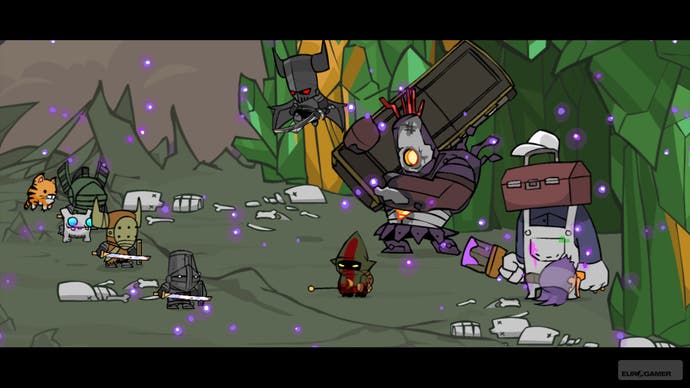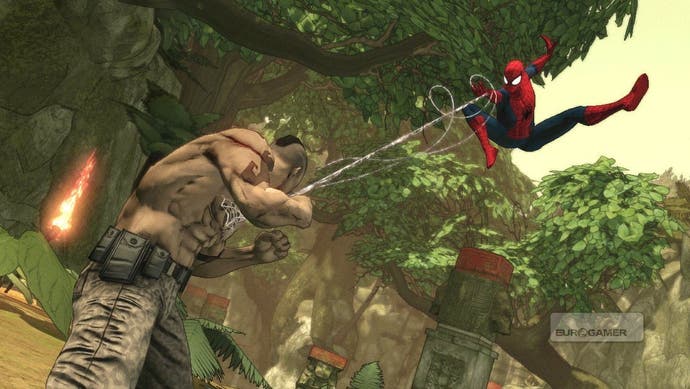Is PEGI too tough?
The ratings game.
Later this year PEGI will become the legally enforceable ratings body for games in the UK, completely replacing the BBFC. Wherever creative content is legislated in this way, friction is inevitable. And almost always, controversy arises because a rating is seen to be making it too easy for inappropriate material to reach the jam-stained fingers of our innocent children.
The recent furore over We Dare, Ubisoft's dreary collection of allegedly saucy mini-games, is a good example of what can happen when content and context fail to align.
PEGI rated it as 12 because there was nothing in the game itself, according to their guidelines, that warranted a higher rating. Whatever sexy facade We Dare wore came from its advertising, not what was on the screen.
Over the last few years, however, there has been a curious creep in the opposite direction. Games that seem relatively benign have been rated suitable only for those aged 16 and over.
For me, the parent of a keen gaming 8 year-old increasingly curious about what lies behind those age-related barriers and the editor of Eurogamer's site for kids, Megaton, things weren't adding up.
My curiosity was piqued in 2008 when my son fell in love with Castle Crashers, The Behemoth's deliciously silly scrolling beat-em-up. The game featured a few small spurts of blood and lots of poo jokes, but after playing it from beginning to end, I struggled to see why it had been deemed suitable only for 16 year-olds.
It seemed like a ludicrous decision, especially when the only explanation on the PEGI website was that this highly stylised cartoon game contained "realistic-looking violence".

This stood in stark contrast to Naughty Bear, rated 12, a game so sadistic and violent that the PR responsible for sending me a copy actually made a point of saying that it really wasn't suitable for kids. Looking for clarification, the PEGI rating explained that while Naughty Bear also contained "realistic looking violence", it was aimed at "non-human characters".
The same actions carried out on humans would basically make the game Manhunt 2. Against ironic cuddly toys, the violence was literally child's play. Something felt wrong.
Examples have continued to crop up over the past year, suggesting PEGI was perhaps struggling to bridge the gap between 12 and 16. Iron Man 2 and Prince of Persia: The Forgotten Sands, for instance, were rated 16 for 360 and PS3 players - but 12 for Wii owners, despite being virtually identical.
Spider-Man: Shattered Dimensions and Star Wars: The Force Unleashed were rated 16, the same rating dished out to grisly foul-mouthed shooters like Metro 2033 and Crysis 2, despite featuring no sex or bad language and only bloodless violence.
The comic book action of Batman: Arkham Asylum was rated 16, even though its admittedly hard-hitting combat was nowhere near as grisly as the 12A rated Dark Knight movie, with a pencil-in-eyeball gag, cheek-slashing, a man with a bomb sewn under his skin and Harvey Dent's gruesomely realistic facemeat.

The notion that I couldn't cover Batman, Spider-Man and Star Wars games on a website aimed at 12-year-olds seemed daft. It bothered me that it was only because my job involved playing those games, and seeing what they contained, that the discrepancy was obvious. Parents with no gaming experience would be making decisions based on what I saw as skewed information.
Finally, I decided to get in touch with PEGI to find out exactly how some of these ratings were determined and what criteria the organisation uses to reach its decisions.
The way PEGI works is that publishers submit their games along with an assessment form, detailing all content that could affect the final rating. On the form are 50 categories which break down every possible type of violence, profanity or sexual content into different age-restricted bands.
"Depictions of violence that is humorous and is set in a cartoon, slapstick or child-like setting" would result in a rating suitable for 3 year-olds. "Moving images that depict mutilation or torture of human-like or animal-like characters" naturally lead to an 18.
Illegal drugs are inappropriate for a 12 rating, but fine under a 16. Sexual innuendo is OK for a 12 rating, but more explicit sex talk bumps things up to a 16. "Realistic violence" against fantasy characters is allowed for a 12, as is non-realistic violence against human characters.








